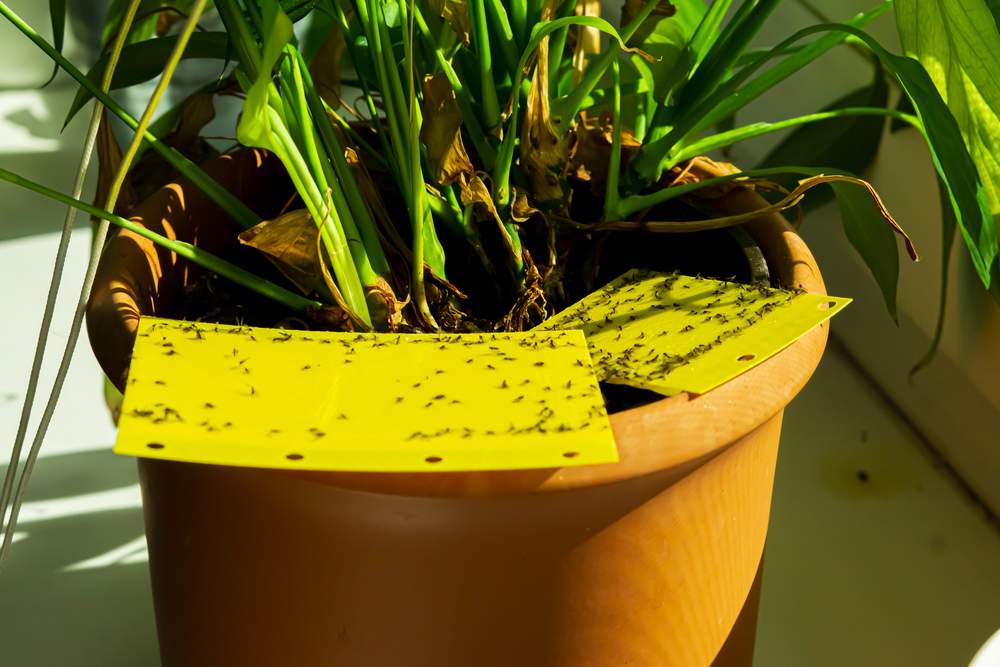


What Are Gnats?
Gnats are tiny winged insects, typically measuring no more than ¼-inch in size, come in various colors such as yellow, tan, black, or brown, and are characterized by their long legs in proportion to their bodies and wide, flat wings. While some gnats serve as pollinators and play a beneficial role in ecosystems, others seem like mere pests from a human perspective.
Although gnats can bite and potentially transmit certain diseases, they do not cause structural damage to homes like other insects. Generally, they are considered to be nuisances rather than significant threats.
Several varieties of gnats can become bothersome within residential spaces. Where these gnats are found can be one of the most helpful indications of the type of infestation folks might have
For example, fruit flies are attracted to decaying fruits and vegetables, fungus gnats are drawn to overwatered plant roots, and drain flies thrive in moist environments and decomposing food found in sink drains.
Outdoors, the activity of gnats is influenced by factors such as temperature, humidity, and light conditions. They tend to be more active when the weather is warm and humid, as these conditions favor their breeding and feeding habits. Also, gnats are often more active in the early morning and late afternoon, around dawn and dusk.
Outdoors, biting gnats, also known as biting midges or no-see-ums, typically originate from aquatic or semi-aquatic environments. Here's a breakdown of their life cycle:
Breeding Sites: Biting gnats lay their eggs in moist areas such as marshes, ponds, swamps, or other bodies of water with organic matter. Some species also breed in damp soil or rotting vegetation.
Larval Stage: The eggs hatch into larvae, often called "bloodworms" or "wrigglers." These larvae are aquatic and live in the water or moist soil. They feed on microorganisms, organic debris, and sometimes small insects.
Pupal Stage: After the larval stage, the gnats transform into pupae. During this stage, they are non-feeding and develop within a protective case.
Adult Stage: Once fully developed, the pupae emerge as adult gnats. These adult gnats have wings and are capable of flying. The females are the ones that bite, as they require a blood meal to reproduce.
Both male and female gnats feed on plant nectar. In some species, the females also need a blood meal to make eggs.
When a gnat bites, it uses scissor-like mouth structures to cut the skin. It inserts saliva into the skin, which contains substances called anticoagulants. These substances thin the blood, so it's easier to digest.
How to Get Rid of Gnats
There are almost as many ways to eliminate gnats as there are different types. However, the following are some of the most tried-and-true methods for eliminating gnats and quelling the infestation.
Use a Bug Zapper
One of the most effective methods for controlling and getting rid of gnats is by using a bug zapper. These devices attract gnats and electrocute them, causing them to die and collect at the bottom of the device. Many modern bug zappers on the market are safe for indoor use, so placing one on the counter or near plants can solve a gnat problem quickly.
Other devices use fans to trap bugs and then dehydrate them, and they work without electrocution. However, just realize that whether you're using a traditional bug zapper or one of the fan-powered devices, they will trap other bugs that may be beneficial, like honeybees and other pollinators.
Vinegar Traps
When it comes to fruit flies, one of the best methods for getting rid of them is a vinegar trap. There are a couple of ways to set these up:
One method includes setting a bowl near the infestation and pouring apple cider vinegar, a teaspoon of sugar, and a teaspoon of dish soap into the bowl. The sugar will attract the gnats, the dish soap will prevent them from escaping, and the vinegar will kill them.
Another method includes mixing apple cider vinegar and sugar in a bowl, covering the bowl in plastic wrap, and poking holes in the top. Once placed near the infestation, these bowls attract the gnats while preventing them from escaping.
Wine Traps
Another way to trap and kill fruit flies is to use a wine trap. These traps work similarly to vinegar traps except that they use wine past its prime and contains its own sugars. You can set up a bowl with plastic wrap over top or simply leave the bottle open on the counter and trap the drunk gnats inside.
To increase effectiveness (if needed), mix a teaspoon of dish soap into the wine.
Candle Traps
For a quicker, albeit more dangerous, method for killing all sorts of gnats, set up a candle trap in the evening. Fill a pan with about ¼-inch of water and a bit of dish soap (about a teaspoon) and sit it on the counter. Place a candle holder in the water, and put a candle in the holder. Light the candle and turn off all the lights.
Gnats will be attracted to the flame. They may attempt to fly into the flame or simply fall into the soapy water and die.
Drain Cleaner
To get rid of drain flies or drain gnats:
Bleach Drains
Another method for drain flies is to pour a cup of bleach down the drain. Like the drain cleaner, pour slowly to ensure the bleach has time to kill all the gnats and larvae. Also, ensure no other chemicals are in the drain to prevent creating harmful fumes.
For outdoor problems, reduce watering.
This might be hard for some green thumbs, but skip watering those plants. Letting plants dry out a bit between watering will kill larvae, preventing them from thriving off of the fungus on the plant's roots.
Use Sticky Paper or Cards
Another option that can work for all types of gnats is sticky paper or cards. These cards are yellow—a color that gnats are attracted to— and have adhesive on their faces. As soon as the gnats land on them, they get stuck and dehydrate. Small cards can be placed in plant pots, hanging ribbons and other versions available. As these cards fill up, simply throw them out and replace them.
Professional Gnat Control Services.
Should you have an outdoor gnat infestation the process to treat them will be similar to treating mosquitoes and the most effect control is achieve by combining different methods. Should you wish the kill off gnats quickly for a party or event held on your property call for a Pre Party Treatment.
Permakill Exterminating provides for Pre Party yard spraying services to knock down pest populations before an outdoor event. If your located in Morris County, NJ or the surrounding areas, Permakill will help make your event pest free.